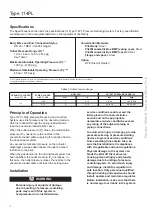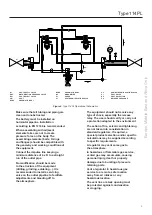
2
Europe, Middle East and
Africa Only
Type 114PL
Specifications
The Specifications section lists the specifications for Type 114PL Pressure Reducing System. Factory specification
are stamped on the nameplate fastened on the regulator at the factory.
Body Sizes and End Connection Styles
DN 25 / 1 NPS - CL600 Flanged
Outlet Pressure Range (P
d
)
(1)
1.0 to 18 bar / 14.5 to 261 psig
See Table 1
Maximum Allowable Operating Pressure (P
s
)
(1)
100 bar / 1450 psig
Maximum Obtainable Operating Pressure (P
u
)
(1)(2)
85 bar / 1233 psig
Construction Materials
Pilot Body:
Steel
Pilot Manometric Box BMP (spring case):
Steel
Pilot Manometric Box BMP (cover):
Steel
Flange and spacer:
Steel
Option
RPE (Electric Heater)
1. The pressure/temperature limits in this Instruction Manual or any applicable standard limitation should not be exceeded.
2. In extreme conditions (isopropanol, methanol)
Table 1
. Outlet Pressure Ranges
PNEUMATIC-LOADED
PILOT TYPE
SPRING-LOADED
PILOT TYPE
NOZZLE Ø
OUTLET PRESSURE RANGE (P
d
)
mm
In.
bar
psig
114
114E
4
0.16
1 to 4.8
14.5 to 69.6
071E
4
0.16
4.8 to 18
69.6 to 261
Principle of Operation
Type 114PL High-pressure Reducing and Low-flow
System uses inlet pressure as the operating medium,
which is reduced through the spring-loaded pilot to
load the pneumatic-loaded pilots’ cases.
When the outlet pressure (P
d
) drops, the motorization
pressure (P
m
) opens more the nozzles in the
pneumatic-loaded pilots supplying the required flow to
the downstream system.
Any excess motorization pressure on the actuator
diaphragm escapes downstream through the bleed
restriction in the pilot.
When the gas demand in the downstream system has
been satisfied, the outlet pressure (P
d
) increases. In
this case, the outlet pressure closes the nozzles in the
pneumatic-loaded pilots until reach the setting value.
Installation
▲
WARNING
Personal injury or equipment damage,
due to bursting of pressure-containing
parts may result if this system is
overpressured or is installed where
service conditions could exceed the
limits given in the characteristics
section and on the appropriate
nameplate or where conditions exceed
any rating of the adjacent piping or
piping connections.
To avoid such injury or damage, provide
pressure-relieving or pressure-limiting
devices to prevent service conditions
from exceeding those limits. Also, be
sure that installation is in compliance
with all applicable code and regulations.
Physical damage to the system can
break the pilot off the main valve,
causing personal injury and property
damage due to bursting of pressure-
containing parts. To avoid such injury
and damage, install the regulator in a
safe location. Only personnel qualified
through training and experience should
install, operate and maintain a regulator.
Before installation, make sure that there
is no damage to or debris in the system.






















